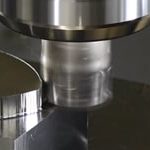Choosing a spindle
Choosing a spindle
April 2009 Machine Technology column
There are three kinds of machine tool spindles: belt driven, coupled motor and integral motor. What's right for your shop?
It may surprise some people but "belt-driven spindles provide the 'best bang for the buck' in regards to spindle drive designs," said Jeff Clark, vice president of sales and marketing for Setco Sales Co., Cincinnati.
That's why they are so common in standard machining operations. But belt-driven technology is also suitable for specialty machining. This is not just because of the ease in sizing belts but also because of positive tooth designs and the use of materials like Kevlar that extend belt life, Clark noted.
Last year, Colonial Tool Group Inc., Taylor, Mich., saw a significant increase in dedicated transfer machine sales compared to CNC technology, noted Paul Thrasher, company president. "Therefore, the belt- and gear-driven spindles increased significantly," he added. The machinery in a dedicated transfer line typically uses a custom belt-driven system for spindles.
The belt-driven technology is still the most popular spindle design and also offers the lowest maintenance cost.
Nor are belt-driven spindles only for low-end machines. "There are high-end, belt-driven machines," said John Easley, vice president sales and marketing, Fischer Precise USA, Racine, Wis. "Spindle technology is more tied to rpm than low- or high-end machine tools."
Another option, coupled-motor spindles, have grown in popularity over the past few years because they are now able to achieve higher speed capabilities, according to Clark. Many machine builders promote coupled-motor spindles because of their low noise and vibration levels.
As for motorized spindles, their use is growing as the industry further develops high-speed machinery. Additionally, 5-axis machines with a swivel head require a motorized spindle because of the machine's mechanical design, according to Hurco Cos. Inc., Indianapolis.
Motorized spindles provide "wide adaptability in terms of allowable speed ranges, features and ease of maintenance. So depending on the application requirements, this spindle type is helpful as a self-contained package," Easley said.
Of the three spindle designs, integral-motorized spindles are considered to be the best, Clark said, especially for high-speed applications. "Belt-driven and coupled-motor designs are usually limited to 15,000 rpm for most CNC work," he added. "Integral-motorized spindles with appropriate, balanced tooling can run at 1.6 times that." Unfortunately, they are also usually the most expensive to buy, repair and replace.
Do you really need a motorized spindle? For many jobs, the benefits aren't substantial enough to justify the cost, according to Hurco. Further, find out what the builder has done to protect the spindle's bearing system. Bearing failure, often due to coolant issues, is the most common cause of spindle failure. For existing machines, Hurco added, the best way for a shop to extend spindle life is to use balanced, high-quality tooling.
Advancements in electronics and miniaturization have led to the use of additional sensors to more finely monitor and optimize spindle performance, said Fischer Precise's Easley. Such developments include thermal sensors for individual bearings and acoustic sensors for tool contact. A further trend is "more power in a more compact spindle size, which means that overall machine mass, in many cases, can be reduced to perform the same work as in the past," Easley said.
The increasingly compact design of motors and their greater torque and power capacity at low speeds "allows the spindle builder to offer a spindle to cover a wider range of speeds and power curves than in the past, making flexible machining systems more flexible," said Colonial's Thrasher.
With the increasingly high-tech nature of machine tools, however, new challenges arise. There is, for example, "the increasing reliance on support services to assist in maximizing uptime of the machine," Thrasher said. "Many end users no longer can service their spindles in-house. Choosing the right service partner is paramount."
So what should you look for in a partner? According to Thrasher, opt for the one who seeks to become familiar with the customers' production processes as well as spindle and tool dynamics through vibration analysis. The partner should also stock spare parts and entire spindles. The cost savings can be significant in terms of "merely increasing spindle uptime," Thrasher noted.
The most important part of choosing a spindle is knowing what it will be used for. Know your shop in terms of your customers' demands and your capabilities—and what you would like your machine tools to do. "Recognize there is no true 'all-in-one' spindle to handle all jobs" advised Easley. CTE
About the Author: George Weimer, a freelance writer based in Lakewood, Ohio, has an extensive background in the metalworking industry's business press. Contact him by e-mail at [email protected].





